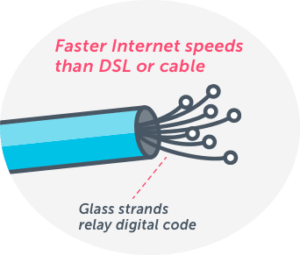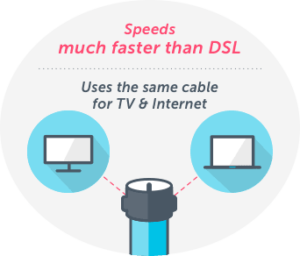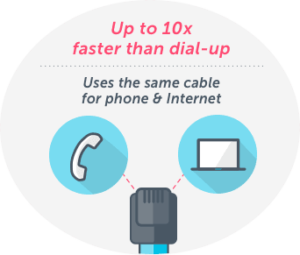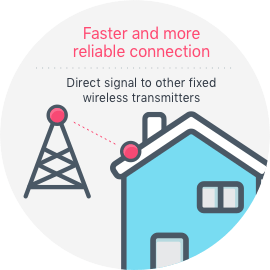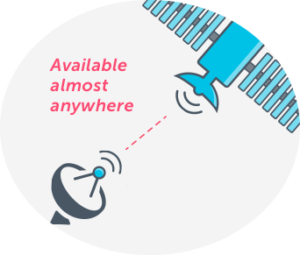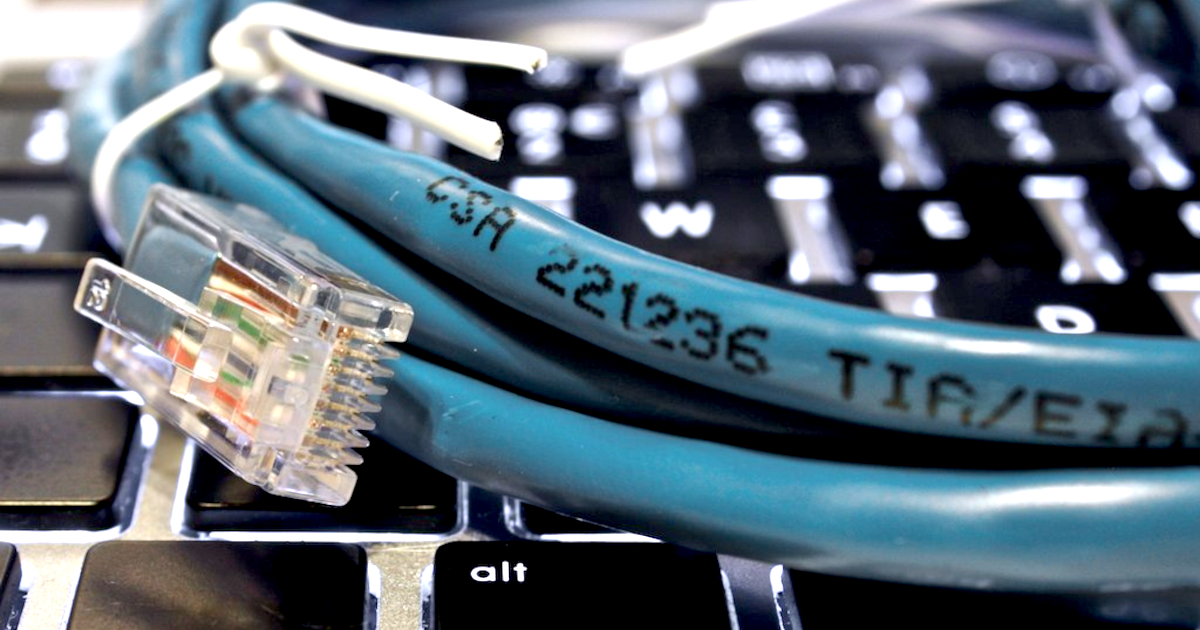What Type of Internet Do You Have at Home?
Apr 5, 2024 | Share
Brand Guides
Internet comes in several different connection types—and the type of connection you have plays a big part in determining how fast, reliable, and costly your internet is.
Fiber internet is the fastest connection you can get, but it’s also the hardest to find. Cable is also reliable and has speeds faster than DSL internet. There’s also 5G internet, a promising and affordable new type of service, but it may be a while before it’s widely available to the public.
So which internet type is best for you?
We put together a guide to help you figure that out. Read on to get all the details of how these types work, how much they cost, and what speeds you can get from each.
And of course, use our zip check tool below to see what type of internet you can get in your area.
What types of internet are available?
| Internet type | Max speed | Price | Availability (for % of US population)* | View all plans online |
|---|---|---|---|---|
| Fiber | 10,000Mbps (10Gbps) | $25.00–$299.95/mo. | 39% | View Plans |
| Cable | 10,000Mbps (10Gbps) | $19.99–$109.99/mo. | 89% | View Plans |
| DSL | 140Mbps | $27.99–$69.99/mo. | 88% | View Plans |
| 5G | 1,100Mbps (1.1Gbps) | $50.00–$90.00/mo. | N/A** | View Plans |
| 4G LTE | 9–50Mbps | $40.00–$100.00/mo. | N/A** | View Plans |
| Fixed wireless | 100Mbps | $39.95–$99.00/mo. | 46% | View Plans |
| Satellite | 100Mbps | $30.00–$150.00/mo. | 100% | View Plans |
Data as of 3/16/2021. Offers and availability may vary by location and are subject to change.
*Percentages are based on internet availability data from the Federal Communications Commission.
**Figures not currently available.
DSL, fiber, and cable
DSL, fiber, and cable are the most common types of internet services available. They’re the fastest, most accessible, and most affordable connections for the vast majority of internet customers in the United States.
Fixed wireless
Fixed wireless isn’t as common, but it comes in handy if you want an alternative to the main providers in town. If you live in a neighborhood with poor cable or DSL coverage, for example, or a rural area without many internet options to choose from, fixed wireless is a good choice.
5G
5G is a relatively new technology based on wireless cellular networks. It’s not widely available at the moment but could emerge as a solid home internet type over the next few years.
Satellite
You can also get satellite internet, which beams an internet signal down from space. It is by far the most available option out there, but it’s more expensive than other internet connections and delivers slower speeds and less data. It’s really something you’d want only if you live in a rural area with limited options.
What is the best type of internet connection?
The best type of internet is fiber-optic internet because it’s extremely efficient, reliable, and fast. In most cases, fiber tops out at 1,000 Mbps for both download and upload speeds. Indeed, fiber delivers the fastest speeds possible out of any internet type—all the way up to 10,000 Mbps (though 1,000 Mbps is far more common).
However, fiber—which runs on fiber-optic cabling—is also the least commonly available type of internet. If you can’t get it in your area, cable is another excellent internet type. It’s much more readily accessible since it runs on the coaxial wiring provided by large cable companies. The fastest cable internet plan you can get reaches up to 1,200 Mbps in download speeds.
Type your zip code to find different types of internet providers in your area:
How to know what type of internet you have
| Internet provider | Connection type | Customer rating* | Order online |
|---|---|---|---|
|
| DSL, fiber, fixed wireless | 3.9/5 | View Plans |
|
| Cable | 3.9/5 | View Plans |
|
| Cable, fiber | 3.7/5 | View Plans |
|
| Cable, fiber | 3.7/5 | View Plans |

| DSL, fiber | 3.3/5 | View Plans |
|
| Cable, fiber | 3.3/5 | View Plans |
|
| DSL, fiber | 3.6/5 | View Plans |
| DSL, fiber | 3.6/5 | View Plans | |
|
| DSL, fiber | 3.5/5 | View Plans |
| Cable, fiber | 3.6/5 | View Plans | |
|
| Cable | 3.8/5 | View Plans |
|
| Cable | 3.4/5 | View Plans |
|
| Fixed wireless | 3.6/5 | View Plans |
 | Satellite | 3.1/5 | View Plans |
| Satellite | 3.1/5 | View Plans |
*Ratings based on our annual customer satisfaction survey.
To find out what type of internet service you have, you can ask your internet provider. Most internet providers have one type of internet on their network, or two at most. You can also look at your monthly bill, or just look at the cable that connects your modem to the wall, as we explain in the chart below:
| Internet type | How it’s connected (where the cord plugs in) | Customer rating* | View plans |
|---|---|---|---|
| Fiber | Fiber-optic or Ethernet outlet | 3.9/5.0 | View Plans |
| Cable | Coaxial cable outlet | 3.6/5.0 | View Plans |
| DSL | Phone jack | 3.5/5.0 | View Plans |
| 5G | 5G device or 5G fixed-wireless router | 3.9/5.0 | View Plans |
| 4G LTE | 4G LTE phone/hotspot or 4G fixed-wireless router | 3.9/5.0 | View Plans |
| Fixed wireless | Antenna console | 3.9/5.0 | View Plans |
| Satellite | Satellite dish | 3.4/5.0 | View Plans |
*Ratings based on our annual customer satisfaction survey.
Pro tip:
If you want more info about providers and what types of connections they have, see our guide to comparing internet providers.
Fiber internet
$29.99–$299.95/mo.
Speed: 100–10,000 Mbps
Availability: 39% of US population
Animal likeness: Cheetah
Fiber is truly the fastest, most reliable, and most high-tech internet around. Unlike internet connections like cable and DSL, it doesn’t rely on older or potentially outdated communications infrastructure. Instead, it carries data over light signals through its own spiffy network of fiber-optic cabling.
That makes fiber incredibly powerful and fast, capable of reaching up to 10,000 Mbps (although 1,000 Mbps is far more common). It also lets you take advantage of symmetrical internet speeds, boosting uploads to 10 times the speed of what you normally could get otherwise. This way you can upload enormous video files, do Zoom video-conferencing, and complete other upload-heavy tasks with fast speeds and no interruptions.
But fiber also costs more than what you’d usually get from a cable or DSL plan. And the networks are less widespread, so it’s not as readily available.
 Pros:
Pros:
- Efficient connections
- Symmetrical upload and download speeds
 Cons:
Cons:
- Less availability
- Higher prices
What are the best fiber internet plans?
| Provider | Plan | Speed | Price* | Sign up |
|---|---|---|---|---|
| AT&T | Internet 300* | 300 Mbps | $55/mo. | View Plans |
| CenturyLink | Fiber Internet** | 940 Mbps | $75/mo. | View Plans |
*Price after $5/mo Autopay & Paperless bill discount (w/in 2 bills). Plus taxes & fees. Monthly State Cost Recovery Charge in TX, OH, NV applies. One time install chrg may apply. Ltd. avail/areas. Call or go to www.fiber.att.com to see if you qualify.
**Speed may not be available in your area. Maximum download/upload speed of up to 940 Mbps via a wired connection. Paperless billing required. Taxes and fees apply. Offer details. Offer includes professional installation at customer’s eligible location.
Cable internet
$19.99–$109.99/mo.
Speed: 25–2,000 Mbps
Availability: 89% of US population
Animal likeness: Horse
Cable internet is reliable, fast, and pretty much ubiquitous. Most cable internet providers now use fiber in their core network but keep coax cables in place for the “last mile” due to cost.
Believe it or not, the technology is capable of 10,000Mbps (10Gbps) download speeds, but the fastest plan you’ll find right now is 2,000Mbps. Infrastructure upgrades to multigig cable internet are a long work in progress, so you may not see 10Gbps downloads until 2026. DOCSIS 4.0 technology also enables 6,000Mbps upload speeds, meaning cable internet plans with symmetrical speeds may be available in the near future.
In some cases, cable internet can slow down during peak hours since your service draws from a neighborhood-wide network. Cable also tends to feature seasonal price hikes, so your bill can go up after a year or two of service. But cable companies are usually game to negotiate, so don’t be afraid of calling up your provider and asking for a promotional hookup if it’s time for your bill to go up.
 Pros:
Pros:
- Fast speeds
- Frequent promo offers
 Cons:
Cons:
- Possible contract requirements
- Possible data caps
What are the best cable internet plans?
| Provider | Plan | Speed | Price | Sign up |
|---|---|---|---|---|
| Xfinity | Fast | 400Mbps | $55.00/mo.* | View Plans |
| Spectrum | Spectrum Internet® Ultra | Up to 500Mbps (wireless speeds may vary) | $49.99–$69.99/mo.† for 24 mos. | View Plans |
*For 24 months. No term contract. Taxes and equipment not included. Includes $10/mo automatic payments and paperless billing discount.
† For 24 months when bundled. Limited time offer; subject to change; valid to qualified residential customers who have not subscribed to any services within the previous 30 days and who have no outstanding obligation to Charter.
DSL internet
$27.99–$69.99/mo.
Speed: 0.5–140 Mbps
Availability: 88% of US population
Animal likeness: Tortoise
Instead of photons zooming through fiberglass or signals beaming across the latest telecom protocols, DSL internet carries data over the old-school wiring of a landline phone network. That makes DSL many times slower than cable or fiber—and the signal gets even weaker as you get farther away from the main network.
But if you can get 25 Mbps on DSL or faster in your area, you’re pretty much good to go. You won’t be able to rely on it for uploading terabyte-sized film projects to YouTube or doing Netflix movie marathons in 4K resolution. But you can still stream in HD, surf social media, and do plenty of other stuff with minimal issues as long as you live in a small household.
DSL is as widely available as cable. And DSL plans are fairly straightforward when it comes to pricing, so it can be a good option if you need Wi-Fi at a cheap price with minimal fuss.
 Pros:
Pros:
- Wide availability
- Straightforward pricing
 Cons:
Cons:
- Slower speeds
- Inconsistent performance depending on area
What are the best DSL internet plans?
| Provider | Plan | Speed | Price | Sign up |
|---|---|---|---|---|
| CenturyLink | Simply Unlimited Internet 140Mbps | Up to 140 Mbps | $55.00/mo.* | View Plans |
| EarthLink | 80 Mbps Internet | Up to 80 Mbps | $69.95/mo.** | View Plans |
*Rate requires paperless billing. Additional taxes, fees, and surcharges apply. Speeds may not be available in your area.
**with a 12 month contract.
5G internet
$50–$90/mo.
Speed: 40–1,100 Mbps
Availability: Very limited (technology still emerging)
Animal likeness: Unicorn
5G is built on the latest generation of wireless technology, which promises superspeeds of 1,000 Mbps and faster with minimal buffering. But 5G networks are still in the process of coming together, so it may be a few years before 5G home internet becomes a properly viable internet type. Right now availability is very limited, as most wireless companies are focusing on cell phone service. Also, the technology works best in densely-populated areas, so 5G rollouts are mostly focused around towns and cities, for now at least.
Providers like Starry Internet do offer 5G fixed wireless service in some small markets, though—so it’s worth running a search to see if it’s available in your area. Otherwise you will have to access 5G over a phone or hotspot, which requires that you get a 5G device.
 Pros:
Pros:
- Fast speeds
- Low latency
 Cons:
Cons:
- Limited availability since it’s new technology
- High barrier to entry since it requires an expensive 5G device
What are the best 5G internet plans?
| Provider | Plan | Speed | Price | Sign up |
|---|---|---|---|---|
| Verizon | Verizon 5G Home Internet | Up to 1,000 Mbps | $50–$70/mo. | View Plans |
| T-Mobile | T-Mobile 5G Home Internet | 72-245Mpbs | $60/mo. | View Plan |
*Data as of 11/15/2022. Offers and availability may vary by location and are subject to change.
4G LTE internet
$40.00–$100.00/mo.
Speed: 9–50 Mbps
Availability: Limited (technology still emerging)
Animal likeness: Turtledove
4G LTE internet gives you a Wi-Fi connection over a 4G wireless network. It’s what you get when you use the internet data on your phone or a mobile hotspot. But lately it’s also evolved into an option for home internet with the launch of services like Verizon’s 4G LTE Home Internet and T-Mobile Home Internet.
Although the speeds can be inconsistent—since they depend on where you are in relation to the nearest cell tower—4G LTE internet still has some perks, including an affordable price and availability in rural areas. It’s an excellent alternative to satellite internet, since it gives you faster speeds and a lot more data. Cellular carriers are gearing up to expand 4G LTE home internet service nationwide over the next few years, so keep a look out if it’s available in your area.
 Pros:
Pros:
- Available in remote areas where 5G isn’t
- Faster than satellite internet (and has more data too)
 Cons:
Cons:
- Slower than fiber and cable internet
- Hard to find because it’s new technology
What are the best 4G LTE internet plans?
| Provider | Plan | Speed | Price | Sign up |
|---|---|---|---|---|
| Verizon | Verizon LTE Home Internet | 25-50Mbps** | $60/mo. | View Plans |
| T-Mobile | T-Mobile LTE Home Internet | 50Mbps | $50/mo. | View Plan |
*Data as of 11/15/2022. Offers and availability may vary by location and are subject to change.
**Price per month without auto pay & mobile plans. LTE Home Internet options not available in all areas. Pricing is subject to change, plan includes taxes & fees.
Fixed wireless internet
$39.95–$99.00/mo.
Speed: 5–100 Mbps
Availability: 46% of US population
Animal likeness: Pigeon
Fixed wireless technology delivers internet over radio signals beamed to an antenna console that you install in your home. It’s not a particularly common internet type, but it does come in handy in cities with bad internet service and in rural areas where your only other option is satellite internet, which tends to be slower and cost more.
That said, fixed wireless internet will still give you slower speeds and less data for the money compared to cable, DSL, and fiber providers. You’ll likely also have limitations when it comes to monthly data usage. But fixed wireless is usually offered by smaller internet providers, so that means you can get more personalized customer service experience.
 Pros:
Pros:
- Great rural option
- Cheaper than satellite internet
 Cons:
Cons:
- Limited coverage
- Monthly data caps
What are the best fixed wireless internet plans?
| Provider | Speed | Price* | Sign up |
|---|---|---|---|
| Rise Broadband | Up to 50Mbps | $79.95/mo. (with autopay discount) or $75.00/mo. (without autopay) | View Plans |
| AT&T Internet Air | 75–225Mbps | $55.00/mo. | View Plans |
| Provider | Rise Broadband |
| Speed | Up to 50Mbps |
| Price* | $79.95/mo. (with autopay discount) or $75.00/mo. (without autopay) |
| Sign up | View Plans |
| Provider | AT&T Internet Air |
| Speed | 75–225Mbps |
| Price* | $55.00/mo. |
| Sign up | View Plans |
*Data as of 2/29/2024. Offers and availability may vary by location and are subject to change.
Satellite internet
$49.99–$299.99/mo.
Speed: 15–100 Mbps
Availability: 100% of US population
Animal likeness: Space monkey
Satellite internet works by beaming a signal down from satellites in space. That means you can get satellite internet basically anywhere in the US. But it also means your internet will be fairly slow because your signal has to travel literally to space and back again—a distance that could span up to 1,200 miles one way—to reach your computer, tablet, or phone.
Satellite internet could get a lot more spectacular in the near future as companies like SpaceX race to launch LEO (low-Earth orbit) satellites into the cosmos to provide improved speeds and reduced latency. Until then, we recommend satellite internet as a fallback if you can’t get any other type of internet service.
 Pros:
Pros:
- Nationwide availability
- Potential for growth with new tech
 Cons:
Cons:
- Slow speeds and high latency
- Low data limits
What are the best satellite internet plans?
| Provider | Plan | Speed | Price | Sign up |
|---|---|---|---|---|
| Hughesnet | Fusion | 100Mbps | $94.99/mo. for 12 mo.* | View Plans |
| Viasat | Viasat Unleashed | 50–150 Mbps | $99.99–$119.99/mo.** | View Plans |
| Provider | Hughesnet |
| Plan | Fusion |
| Speed | 100Mbps |
| Price | $94.99/mo. for 12 mo.* |
| Sign up | View Plans |
| Provider | Viasat |
| Plan | Viasat Unleashed |
| Speed | 50–150 Mbps |
| Price | $99.99–$119.99/mo.** |
| Sign up | View Plans |
Data as of 4/5/2024. Offers and availability may vary by location and are subject to change.
*Offer for 12 months. Service plans require a 24-month commitment. Equipment Lease or Purchase fees extra. Service plans require a 24-month commitment. Equipment Lease or Purchase fees extra.
**Prices and availability vary by location. Installation fees, monthly equipment lease fees, and taxes may apply. After 150 GB of High-Speed Data usage, you still have unlimited access to Standard Data, which may result in slower speed.
FAQ about internet types
What type of internet connection do I have?
The type of internet connection you have is determined by your internet provider. You can either have fiber, cable, DSL, satellite, or fixed wireless internet. Some customers may also have access to 5G or another type of internet through their cell provider or a company like Starry Internet.
What is the most common type of internet connection?
The most common type of internet connection is cable. According to the Federal Communications Commission (FCC), it’s available to 89% of the US population.
DSL is also extremely common. It’s accessible to 88% of the US population, according to the same FCC data. By comparison, fiber internet is available to just 39% of the population.
How do I know my internet connection type?
You can find out your internet connection type by checking to see what kind of connection you have between the network and your modem. Here’s what to look for:
- Connection through the phone jack—DSL internet
- Connection through the coaxial cable outlet—cable internet
- Connection through a fiber or Ethernet jack—fiber internet
- Connection through an antenna console—fixed wireless internet
- Connection through a satellite dish—satellite internet
To find out your internet type, you can also ask your internet service provider (ISP) or look on your ISP’s website.
Punch in your zip code to see what internet providers and internet connection types are available in your area:
Author - Peter Holslin
Peter Holslin has more than a decade of experience working as a writer and freelance journalist. He graduated with a BA in liberal arts and journalism from New York City’s The New School University in 2008 and went on to contribute to publications like Rolling Stone, VICE, BuzzFeed, and countless others. At HighSpeedInternet.com, he focuses on covering 5G, nerding out about frequency bands and virtual RAN, and producing reviews on emerging services like 5G home internet. He also writes about internet providers and packages, hotspots, VPNs, and Wi-Fi troubleshooting.
Editor - Cara Haynes
Cara Haynes has been editing and writing in the digital space for seven years, and she's edited all things internet for HighSpeedInternet.com for five years. She graduated with a BA in English and a minor in editing from Brigham Young University. When she's not editing, she makes tech accessible through her freelance writing for brands like Pluralsight. She believes no one should feel lost in internet land and that a good internet connection significantly extends your life span.
